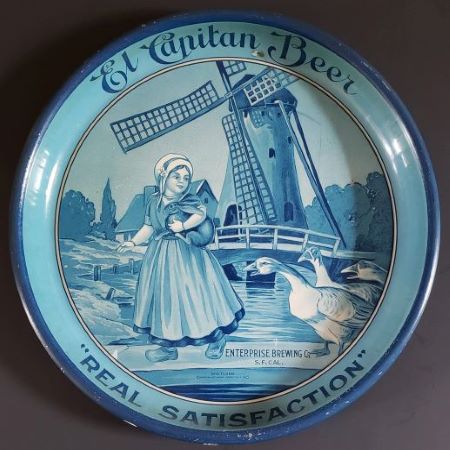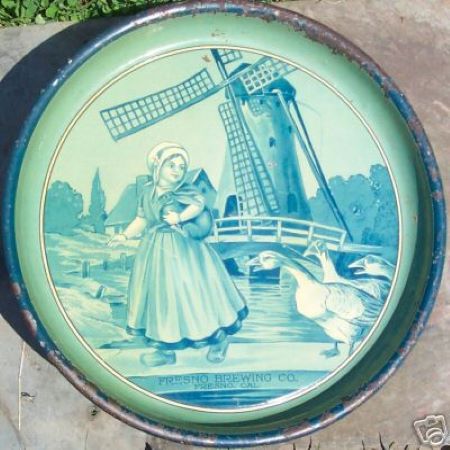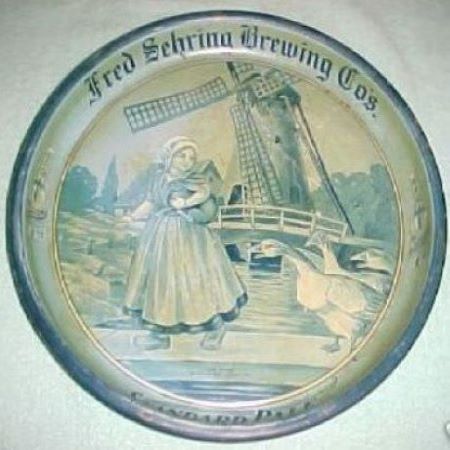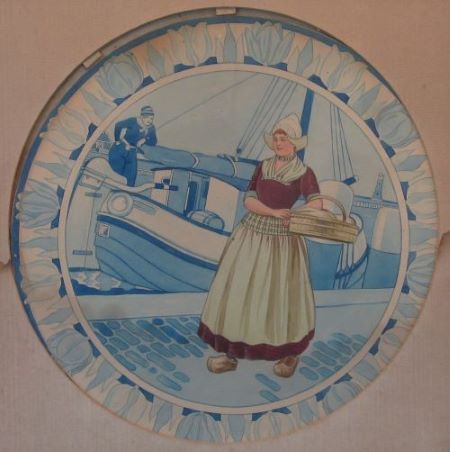The 'Stock' Exchange
American Art Works: No. 145 "Gretchen"
American Art Works: No. 145 "Gretchen"
Date: 1916 to 1920
Size: 13"
Type: Pie
Scarcity: Uncommon
Value: $$ to $$$
Condition & Brewer Dependent
Size: 13"
Type: Pie
Scarcity: Uncommon
Value: $$ to $$$
Condition & Brewer Dependent

General
No. 145 “Gretchen” is one of two American Art Works attempts at a “delft” (or more properly 'delftware') look to a stock design. It is an example of trompe l’oiel in the same sense that the Japanese inspired “lacquerware” (No.'s 59, 83, and 94) and woodgrain trays (No.'s 114, 115, 139, and 142), fooling the viewer into believing it was actual delftware. Cross-town competitor H.D. Beach probably best perfected this style among the tray manufacturers (in addition to American Art Works, Kaufmann & Strauss also had a “delft” design).
Delft is a city and municipality in the province of South Holland, Netherlands (you know, that country where all those beer drinking “Dutch” immigrants to American supposedly came from). Delft is well known for the Delft pottery ceramic products which was styled on the imported Chinese porcelain of the 17th century. The city had an early start in this area since it was a home port of the Dutch East India Company.
No. 145 “Gretchen” is one of two American Art Works attempts at a “delft” (or more properly 'delftware') look to a stock design. It is an example of trompe l’oiel in the same sense that the Japanese inspired “lacquerware” (No.'s 59, 83, and 94) and woodgrain trays (No.'s 114, 115, 139, and 142), fooling the viewer into believing it was actual delftware. Cross-town competitor H.D. Beach probably best perfected this style among the tray manufacturers (in addition to American Art Works, Kaufmann & Strauss also had a “delft” design).
Delft is a city and municipality in the province of South Holland, Netherlands (you know, that country where all those beer drinking “Dutch” immigrants to American supposedly came from). Delft is well known for the Delft pottery ceramic products which was styled on the imported Chinese porcelain of the 17th century. The city had an early start in this area since it was a home port of the Dutch East India Company.
It was particularly known for designs in “deflt blue” and sometimes the pottery itself is referred to as Delft Blue, although other colors were produced. Delftware ranged from simple household items – plain white earthenware with little or no decoration – to fancy artwork. Pictorial plates were made in abundance, illustrated with religious motifs, native Dutch scenes with windmills and fishing boats, hunting scenes, landscapes and seascapes.
Gretchen is the German diminutive of Margareta (Margaret). Grete, Greta and Gretel also developed as diminutive forms of Margareta in Germany, names which eventually spread beyond the German borders. Margareta, like Margaret, both originated from the Hebrew “margaron” meaning “pearl” (as a diminutive form, Gretchen therefore means “little pearl”). In German-speaking countries, Gretchen is not a common stand-alone given name but rather a colloquial diminutive form of Grete (Greta). It fell out of use when the popularity of Margareta declined in the 20th century. Its popularity had increased in the 19th century because a major character in Goethe's Faust (1808) has this name. In German, the Gretchenfrage (question by Gretchen), is an idiom for a direct question that aims at the core of a problem and that should reveal the intentions and mindset of the one questioned. The question is usually inconvenient to the person questioned since he or she is pressured to confess to something crucial he or she was intentionally or unintentionally vague about before. We also saw references to Gretchen/the Gretchenfrage as “pain in the ass.” In the United States the name was never especially popular but reached its peak in the mid-1970s.
Gretchen is the German diminutive of Margareta (Margaret). Grete, Greta and Gretel also developed as diminutive forms of Margareta in Germany, names which eventually spread beyond the German borders. Margareta, like Margaret, both originated from the Hebrew “margaron” meaning “pearl” (as a diminutive form, Gretchen therefore means “little pearl”). In German-speaking countries, Gretchen is not a common stand-alone given name but rather a colloquial diminutive form of Grete (Greta). It fell out of use when the popularity of Margareta declined in the 20th century. Its popularity had increased in the 19th century because a major character in Goethe's Faust (1808) has this name. In German, the Gretchenfrage (question by Gretchen), is an idiom for a direct question that aims at the core of a problem and that should reveal the intentions and mindset of the one questioned. The question is usually inconvenient to the person questioned since he or she is pressured to confess to something crucial he or she was intentionally or unintentionally vague about before. We also saw references to Gretchen/the Gretchenfrage as “pain in the ass.” In the United States the name was never especially popular but reached its peak in the mid-1970s.
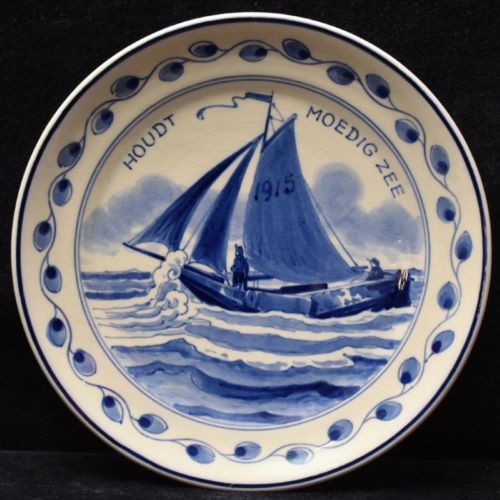
Blue Delft Plate
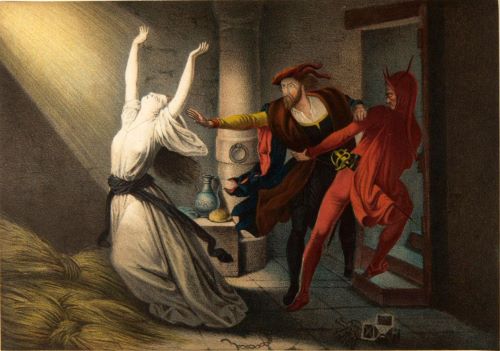
Shakespeare's Gretchen in Faust
Joseph Fay (1812-1875), Illustration for Faust (1846), colour lithograph, in 'Faust - the Tragedy Part 1', Paris 1846.
Hager & Price
Hager stopped commenting on specific trays after No. 136 and he does not include this design in his date of introduction table, but he does include it in his catalog with the proper stock number (No. 145). Comparatively, a large percentage of examples of this design seem to be found in poor to below average condition, but even better examples even from brewers only achieve low three figures. Most examples we’ve encountered have been in the mid-double figures.
Hager stopped commenting on specific trays after No. 136 and he does not include this design in his date of introduction table, but he does include it in his catalog with the proper stock number (No. 145). Comparatively, a large percentage of examples of this design seem to be found in poor to below average condition, but even better examples even from brewers only achieve low three figures. Most examples we’ve encountered have been in the mid-double figures.
There are a lot of different elements in this design that we were trying to make sense of—the windmill, her traditional outfit, the geese and the rabbit she is carrying --but we couldn’t quite bring it altogether collectively. In the end we are inclined to believe that the anonymous artist threw together a hodge-podge of Dutch stereotypes that the viewer would recognize. Although we do wonder about the lack of tulips.
Sahling's Design Notes
Sahling does not have an entry in his workbook for this design. Although example do carry a © symbol, they are not dated. Revisions to the copyright law in 1909 removed the requirement for the inclusion of the date and some other design examples also do not carry a date, but many do. It is unclear why American Art Works was inconsistent with this.
Size, Shape and Message Placement
All of the examples we’ve seen of this design carrying advertising have been concave pies. These feature a plain, pale blue rim with dark blue advertising text and matching dark blue edges. We have never seen advertising on the face of the tray like with have with its companion “delft” design, “Katrina” (No. 146). Although we have never seen a sign version, we have encountered a framed, flat version that looks like an unpressed tray that features Gretchen in color and has a tulip rim design. There is a corresponding “Katrina” version as well.
Sahling's Design Notes
Sahling does not have an entry in his workbook for this design. Although example do carry a © symbol, they are not dated. Revisions to the copyright law in 1909 removed the requirement for the inclusion of the date and some other design examples also do not carry a date, but many do. It is unclear why American Art Works was inconsistent with this.
Size, Shape and Message Placement
All of the examples we’ve seen of this design carrying advertising have been concave pies. These feature a plain, pale blue rim with dark blue advertising text and matching dark blue edges. We have never seen advertising on the face of the tray like with have with its companion “delft” design, “Katrina” (No. 146). Although we have never seen a sign version, we have encountered a framed, flat version that looks like an unpressed tray that features Gretchen in color and has a tulip rim design. There is a corresponding “Katrina” version as well.
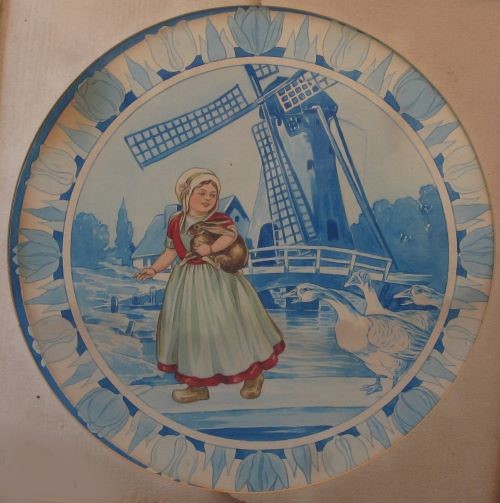
"Gretchen" No. 145
"Katrina" No. 146

Confirmed Brewer used Stock Trays
Non-Beer Related & Non-Tray Uses
Click the Picture to Return to Meek & Beach Stock Catalog Page
